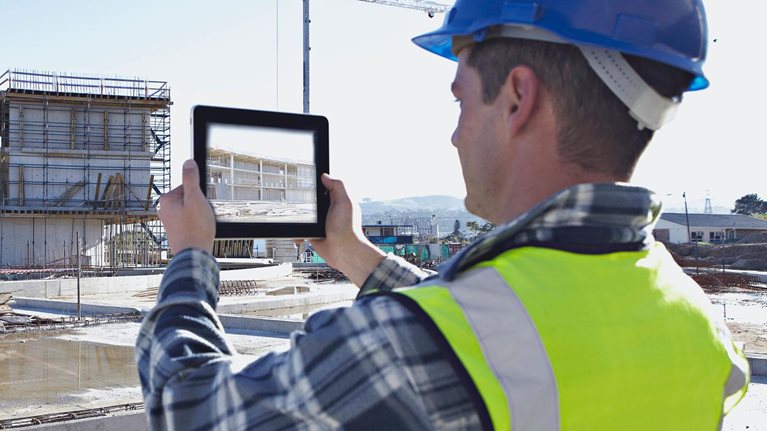As our society overcomes the initial shock of mandated lockdowns, physical distancing, and other measures to slow the spread of COVID-19, it’s becoming clear that these precautions will not end abruptly—even when shelter-in-place orders are lifted around the world. While safety has always been a priority on the construction site, its gravity is taking on new meaning as the industry learns to navigate the immediate and long-term effects of one of the most significant global health crises in memory.
Indeed, construction laborers are watching the job site morph in front of their eyes—and those whose projects have stalled will find a very different experience from the one they left a few months prior. Personal protective equipment (PPE), on-site testing, staggered shifts, increased sanitary requirements, and a partially remote team will transform the construction industry—not only in the near term but potentially for years to come. Given that many are operating with single-digit margins, this next normal threatens project budgets, schedules, and delivery if owners and contractors fail to adapt.
Successful adaptation will require more than setting out hand sanitizer or limiting the number of workers on a buck hoist at once. It will need a fundamental change. The industry has long struggled to implement productivity improvements or fully embrace digital tools; doing so will soon become table stakes. Furthermore, owners can offset the stress on budgets and timelines by embracing a more efficient approach to project execution—that is, shifting the construction component of the engineering, procurement, and construction (EPC) curve. Most owners and contractors launch construction as soon as possible. But in many cases, they can eliminate laborer downtime and ramp up to peak productivity quicker by delaying the start until more of the commodity materials are available. This approach was advisable even before the global pandemic, but the coronavirus-fueled crisis has created a new urgency for the industry to finally change its behavior and accept a new paradigm.
The impact of COVID-19 on the construction site
The realities of COVID-19’s effect on construction sites are stark. Physical-distancing requirements will significantly alter the entire on-site experience, including camp-accommodation design, bussing, canteen layouts, and line management at site entry and exit. Heightened personal safety and hygiene protocols will necessitate on-site temperature screens (and potentially random COVID-19 testing), PPE requirements, and temporary facilities such as washing stations, clean rooms, and stockrooms for masks, gloves, face shields, and so forth. Labordensity restrictions could force contractors to stagger work shifts; increase supervision of physical distancing, safety, and hygiene protocols; and extend the overall duration of construction.
All of these changes will lead to an increase in indirect costs (those not directly associated with materials and installation such as supervision, scaffolding and major equipment, temporary facilities, quality control, safety, and construction management). Typically, these indirect costs account for 35 to 50 percent of overall construction costs; we anticipate it will increase by another 15 to 30 percent. Exact costs will vary depending on project location (including whether it’s urban or requires a worker camp), quality of craft, and construction methodology. It will be driven by a reduction in productivity, increased procurement (for example, of PPE), and—critically—lengthened project timelines. These costs will be built into the overall capital price for construction that owners will now bear. To ensure that projects continue to be viable for owners to develop, initiatives in other areas will be needed to counter these increases: rapidly improving in productivity, working remotely, and digitizing project delivery.
Would you like to learn more about our Capital Projects & Infrastructure Practice?
Mitigating the increase in indirect costs and schedule overruns
We see two imperatives to mitigating the additional costs and schedule overruns caused by the next normal of construction: getting serious about improving productivity using digital tools—particularly those that enable remote work—and embracing a more efficient approach to project execution.
Get serious about improving productivity using digital tools
While introducing initiatives to improve productivity is not new, now more than ever improving productivity will be one of the most significant elements to countering the rise in indirect costs. Many of the productivity initiatives entertained in the past have focused on time and motion studies, tool time, crane time, pipe fit up for welds, craft incentives, and daily planning.
A key component of improving productivity is more broadly embracing digital tools. Indeed, construction remains one of the least digitized industries in the world. But digital use cases can directly address the most common challenges in construction—now exacerbated by COVID-19. Disparate working teams, less site presence, and constrained physical movement amplify the need for even better collaboration, more transparency, and more remote work. Digital twins, for example, provide a virtual replication of the site hosted in the cloud and easily accessible from any location. Drones can scan the site and update progress in the virtual reality in near real time, creating transparency on performance as well as quality—issues are surfaced early, known to all, and can be swiftly addressed. The list of opportunities goes on.
And if there is one thing we’ve learned over these past months of lockdown, it’s that many jobs can continue to be performed remotely and productively. Today’s technology will allow us to transfer roles that have traditionally been performed at site, such as contracts, cost control, finance, and procurement, to the home office—and there are clear cost advantages to doing so. For one, all of the site indirect costs such as camp/accommodation, food, site transportation, PPE, and rotational business travel can all be avoided. Depending on the job location in relation to the home office (such as whether that’s in the same country or camp, around the world, or across the city), this cost could represent anywhere from 15 to 50 percent more than the cost of the equivalent home-office position. On the direct cost side, jobsite positions typically attract uplifts and additional paid work hours, which, again, depending on the jobsite, could cost an additional 20 to 50 percent more than a similar position based in the home office. While roles associated with construction, quality, and safety will always need to be on-site, the opportunity for substantial savings by having nonmanual employees work remotely is clear.
Embrace a more efficient approach to project execution
Often the most significant losses of productivity are a result of poor availability of work fronts—that is, the tasks that can be completed with the materials on hand at the site. Small deviations in design, for example, can have huge impacts on the availability of materials and construction work fronts, leading to craft idle time and construction delays. Time and time again, construction mobilizes too early and quickly chews up all the work fronts available—only to end up waiting on design and material deliverables to continue.
One strategic change that owners and contractors can apply almost immediately is to delay the start of construction until a far greater percentage of engineering and procurement deliverables are available. The trick is not to extend the overall duration of the project but to steepen the construction S-curve so construction starts later but still completes at the same time. By having more work fronts available when construction commences, the commodity curves can ramp up and reach peak productivity much quicker, potentially saving months in the construction duration (Exhibit 1). That can translate into millions of dollars in indirect cost savings. Owners and contractors that master this approach could codify the efficiency changes, improve on budgeted productivity, and even accelerate projects beyond what has been possible in the past.

Consider a hypothetical gas facility to be built in the Middle East, budgeted at $2 billion. The owner asks the EPC contractor to incorporate COVID19 sanitation requirements and enforce physical distancing. Due to labor-density restrictions, the contractor proposes splitting the 6,000 craft workers into two shifts but warns the owner that there will be a productivity impact for the night shift and resulting delay of the construction schedule. Introducing a night shift also entails increasing the number of field nonmanual staff. The overall impact is estimated to be roughly $105 million (5 percent of the project budget) and a loss of four months.
Embracing a more efficient approach to project execution can mitigate both the cost and schedule overruns. In this example, steel installation can start in month five when 50 percent of the steel is on-site, rather than in month one when just 10 percent is on-site. This allows the contractor to attack 20 work fronts at once rather than just five, steepening the construction S-curve by cutting idle time and countering the effect of the reduced productivity (Exhibit 2). Replicating this approach across all major commodities—concrete, pipe, cable, instruments, and so forth—scales the impact.

The contractor is also successful in identifying 22 percent of field positions that can be transferred to the home office, which results in additional savings.1 Positions such as contracts administration, resident engineering, the majority of procurement, finance, and cost control are all transferred. In addition, the contractor can eliminate 17 percent of his field positions by employing digital tools for measuring field progress, surveying, and performing quality control on-site and in the fabrication yards.
By taking these actions, the owner in this hypothetical example would be able to mitigate the four months of schedule delay and recover 89 percent of the impacted cost while maintaining a safe and clean jobsite.
It’s worth noting that this more-efficient approach to construction has always been an option. But owners and contractors tend to stick to the status quo, which prioritizes a series of cosmetic milestones, such as pouring first concrete or erecting first steel, that stand in as an indicator of progress but that don’t have a material effect on the overall timeline. This status quo is ingrained because of a widely held mindset that once you can start construction, you should—even if the optimal course of action would be to wait until enough materials and work fronts are available to support a sustained ramp up. As such, one of the biggest hurdles owners and contractors will need to overcome is their own hesitation to abandon the status quo and embrace a new model. In the era of COVID-19, they may not have much of a choice.
In mere months, the COVID-19 pandemic has already permanently changed the way we do business. It would be naive to assume the current lockdowns and safety precautions are a one-time event. As such, owners and contractors need to prepare for the next normal and embrace permanent, routine safeguards for their jobsites to protect the health and safety of their workers while making project economics work. There is no other option.
Physical distancing, an increasingly remote workforce, expanded use of digital tools—these are the characteristics of the next normal in construction. Those who transition quickly and prepare before construction ramps back up will come out ahead.

